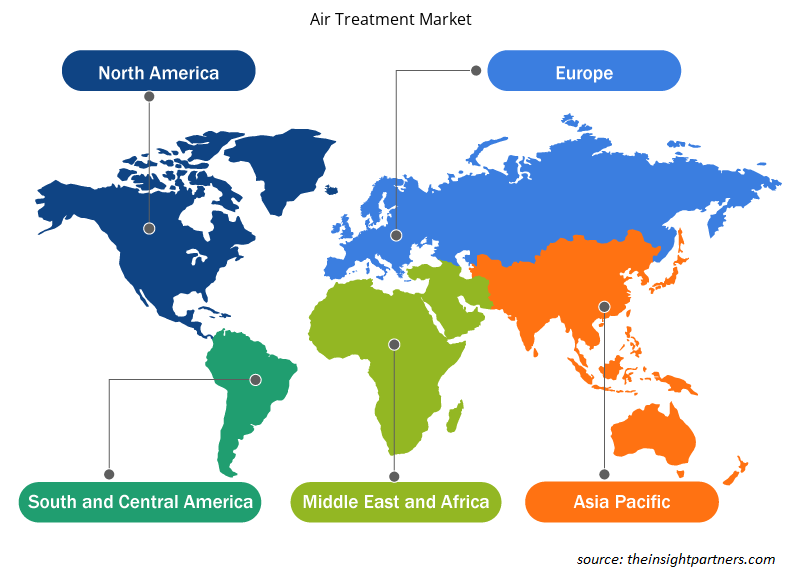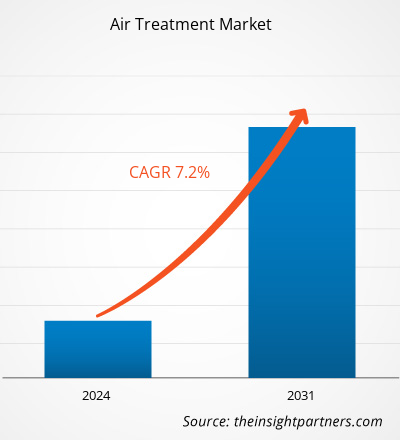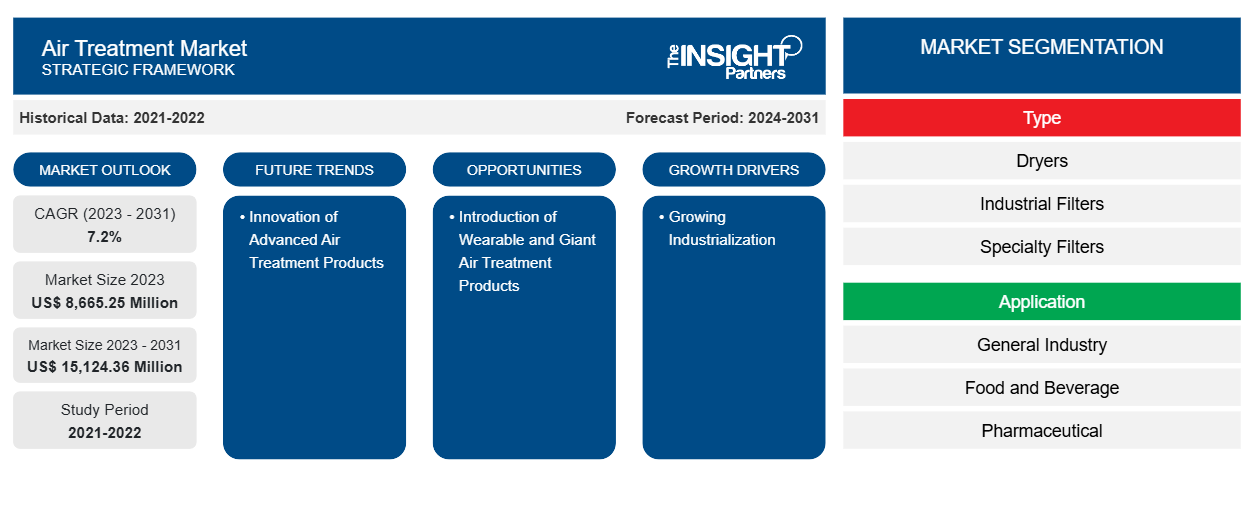Der Markt für Luftaufbereitung wird voraussichtlich von 8.665,25 Millionen US-Dollar im Jahr 2023 auf 15.124,36 Millionen US-Dollar im Jahr 2031 anwachsen. Der Markt wird zwischen 2023 und 2031 voraussichtlich eine durchschnittliche jährliche Wachstumsrate von 7,2 % verzeichnen. Die Innovation fortschrittlicher Luftaufbereitungsprodukte wird voraussichtlich ein wichtiger Trend auf dem Markt bleiben.
Luftaufbereitungsmarktanalyse
Zu den wichtigsten Endverbrauchern des Luftaufbereitungsmarktes zählen die Energie-, Lebensmittel- und Getränkebranche sowie die Petrochemie. Das städtische Wachstum wird in den kommenden Jahren voraussichtlich in Slums und anderen informell bebauten Teilen der Staaten und Länder stattfinden. Darüber hinaus haben günstige Wachstumsbedingungen weltweit und wachsende Infrastrukturprojekte die Wachstumsrate des Luftaufbereitungsmarktes weltweit vorangetrieben.
Marktübersicht zur Luftaufbereitung
Zu den wichtigsten Akteuren im Ökosystem des globalen Luftaufbereitungsmarktes gehören Hardware-/Komponentenanbieter, Luftaufbereitungshersteller/-anbieter und Endnutzer. Komponenten-/Hardwareanbieter liefern Luftaufbereitungsherstellern verschiedene Komponenten/Teile/Rohstoffe für die Herstellung des Endprodukts. Zur Herstellung von Luftaufbereitungsprodukten werden unterschiedliche Arten von Rohstoffen verwendet. Zu den wichtigsten Marktherstellern auf dem globalen Luftaufbereitungsmarkt gehören unter anderem ABIONIK Group GmbH, Beko Technologies, Donaldson Company, Inc., Condorchem Envitech, Parker Hannifin, Kaesar Kompressoren, Mikropor, Odatech Pty Ltd., SPX FLOW, Inc. und Xebec Adsorption Inc.
Passen Sie diesen Bericht Ihren Anforderungen an
Sie erhalten kostenlos individuelle Anpassungen an jedem Bericht, einschließlich Teilen dieses Berichts oder einer Analyse auf Länderebene, eines Excel-Datenpakets sowie tolle Angebote und Rabatte für Start-ups und Universitäten.
-
Holen Sie sich die wichtigsten Markttrends aus diesem Bericht.Dieses KOSTENLOSE Beispiel umfasst eine Datenanalyse von Markttrends bis hin zu Schätzungen und Prognosen.
Treiber und Chancen auf dem Luftaufbereitungsmarkt
Zunehmende Industrialisierung begünstigt Marktwirtschaft
Die Luftaufbereitungsbranche wird direkt oder indirekt durch energische staatliche Maßnahmen zur Unterstützung des Industriesektors vorangetrieben, wie sie beispielsweise in großen Regionen wie Nordamerika und Europa in verschiedenen Foren ergriffen werden. Die Politik in Europa ist für die Entwicklung des Geschäfts von Vorteil, was einer der Gründe für das Wachstum der Elektronikindustrie und der KMU in Europa ist. Die Gründung der EU-Region hat zu einer Erleichterung der Geschäfte sowie des Imports und Exports zwischen den Mitgliedern der Union geführt. Diese Branchen sind in dieser Region sehr verbreitet. Somit steuert die wachsende Entwicklung des Industriesektors die Nachfrage nach dem Luftaufbereitungsmarkt weltweit.
Einführung tragbarer und riesiger Luftaufbereitungsprodukte
Luftfiltersysteme werden installiert, um die Sicherheit an industriellen Arbeitsplätzen zu gewährleisten. Der steigende Trend zu Luftaufbereitungssystemen hilft dabei, kleinste Rauchpartikel in Industriebereichen einzufangen. Die moderne Metallverarbeitung nutzt fortschrittliche Technologie und Automatisierungsprozesse, um Produkte herzustellen, die bei Erhitzungsprozessen schädliche Gase und Rauch als Nebenprodukt des Schweißens freisetzen. Dies hat die Installation von Staubsammelsystemen mit hochwertigen Filterpatronen vorangetrieben. Das zunehmende Aufkommen tragbarer und riesiger Luftaufbereitungsprodukte im Industriesektor ist einer der größten Wachstumschancen für den Markt in den kommenden Jahren.
Segmentierungsanalyse des Luftbehandlungsmarktberichts
Schlüsselsegmente, die zur Ableitung der Marktanalyse zur Luftaufbereitung beigetragen haben, sind Typ und Anwendung.
- Je nach Typ ist der Markt für Luftaufbereitung in Trockner, Industriefilter, Spezialfilter und Kondensatmanagement unterteilt. Das Segment der Industriefilter hatte im Jahr 2023 einen größeren Marktanteil.
- Nach Anwendung ist der Markt in die allgemeine Industrie, Lebensmittel und Getränke, Pharmazie, Öl und Gas, Chemie und Petrochemie sowie Bergbau unterteilt. Das Pharmasegment hielt im Jahr 2023 einen erheblichen Marktanteil.
Luftaufbereitung – Marktanteilsanalyse nach geografischer Lage
Der geografische Umfang des Marktberichts zur Luftaufbereitung ist hauptsächlich in fünf Regionen unterteilt: Nordamerika, Asien-Pazifik, Europa, Naher Osten und Afrika sowie Süd- und Mittelamerika.
Nordamerika ist Marktführer. Die Bevölkerung der USA hat einen hohen Lebensstandard und die Kaufkraft der Menschen ist aufgrund des hohen Pro-Kopf-Einkommens des Landes enorm. Dies führt zur Nutzung von mehr Einrichtungen und erhöht den Ressourcenverbrauch in der Region. Dies wird weiter zu einem steigenden Bedarf an Frischluft im Land führen und somit das Wachstum des Luftaufbereitungsmarktes beeinflussen. Nordamerika ist eine technologisch fortschrittliche Region. Intelligente Luftreiniger haben in dieser Region eine hohe Akzeptanz erfahren. Diese Technologien bieten, wenn sie in Maschinen integriert werden, den Endbenutzern Effizienz. Mehr Einsätze erfordern mehr Wettbewerb in der Region sowie das Wachstum der gesamten Branche, was zu Marktentwicklung und Innovationen führt.
Regionale Einblicke in den Luftaufbereitungsmarkt
Die regionalen Trends und Faktoren, die den Luftbehandlungsmarkt während des Prognosezeitraums beeinflussen, wurden von den Analysten von Insight Partners ausführlich erläutert. In diesem Abschnitt werden auch die Marktsegmente und die Geografie der Luftbehandlung in Nordamerika, Europa, im asiatisch-pazifischen Raum, im Nahen Osten und Afrika sowie in Süd- und Mittelamerika erörtert.

- Erhalten Sie regionale Daten zum Luftaufbereitungsmarkt
Umfang des Marktberichts zur Luftaufbereitung
| Berichtsattribut | Details |
|---|---|
| Marktgröße im Jahr 2023 | 8.665,25 Millionen US-Dollar |
| Marktgröße bis 2031 | 15.124,36 Millionen US-Dollar |
| Globale CAGR (2023 - 2031) | 7,2 % |
| Historische Daten | 2021-2022 |
| Prognosezeitraum | 2024–2031 |
| Abgedeckte Segmente |
Nach Typ
|
| Abgedeckte Regionen und Länder |
Nordamerika
|
| Marktführer und wichtige Unternehmensprofile |
|
Marktteilnehmerdichte: Der Einfluss auf die Geschäftsdynamik
Der Markt für Luftbehandlungsprodukte wächst rasant, angetrieben durch die steigende Nachfrage der Endnutzer aufgrund von Faktoren wie sich entwickelnden Verbraucherpräferenzen, technologischen Fortschritten und einem größeren Bewusstsein für die Vorteile des Produkts. Mit steigender Nachfrage erweitern Unternehmen ihr Angebot, entwickeln Innovationen, um die Bedürfnisse der Verbraucher zu erfüllen, und nutzen neue Trends, was das Marktwachstum weiter ankurbelt.
Die Marktteilnehmerdichte bezieht sich auf die Verteilung der Firmen oder Unternehmen, die in einem bestimmten Markt oder einer bestimmten Branche tätig sind. Sie gibt an, wie viele Wettbewerber (Marktteilnehmer) in einem bestimmten Marktraum im Verhältnis zu seiner Größe oder seinem gesamten Marktwert präsent sind.
Die wichtigsten auf dem Markt für Luftaufbereitung tätigen Unternehmen sind:
- Beko Technologies
- Donaldson Company, Inc.
- Parker Hannifin
- Honeywell International Inc
- Hongrijia Depurate Facility Science-Technology Co., Ltd.
- Ingersoll Rand Inc.
Haftungsausschluss : Die oben aufgeführten Unternehmen sind nicht in einer bestimmten Reihenfolge aufgeführt.

- Überblick über die wichtigsten Akteure auf dem Luftaufbereitungsmarkt
Neuigkeiten und aktuelle Entwicklungen auf dem Luftaufbereitungsmarkt
Der Markt für Luftbehandlung wird durch die Erhebung qualitativer und quantitativer Daten nach Primär- und Sekundärforschung bewertet, die wichtige Unternehmensveröffentlichungen, Verbandsdaten und Datenbanken umfasst. Nachfolgend sind einige der Entwicklungen auf dem Markt für Luftbehandlung aufgeführt:
- Ingersoll Rand Inc., ein globaler Anbieter unternehmenskritischer Lösungen zur Flusserzeugung und Industrie, hat die Übernahme von Friulair Srl („Friulair“) zu einem Barkaufpreis von rund 146 Millionen US-Dollar abgeschlossen. (Quelle: Ingersoll Rand Inc, Pressemitteilung, Februar 2024)
- Honeywell International Inc. hat seinen Indoor Air Quality (IAQ)-Monitor auf den Markt gebracht, der Gebäudeeigentümer und -betreiber auf potenzielle Probleme aufmerksam macht, um die Luftqualität in Innenräumen proaktiv zu verbessern und so möglicherweise das Risiko der Übertragung von Luftschadstoffen zu verringern. (Quelle: Honeywell International Inc., Pressemitteilung, Februar 2022)
Marktbericht zur Luftaufbereitung – Umfang und Ergebnisse
Der Bericht „Marktgröße und Prognose für die Luftaufbereitung (2021–2031)“ bietet eine detaillierte Analyse des Marktes, die die folgenden Bereiche abdeckt:
- Luftbehandlungsmarktgröße und -prognose auf globaler, regionaler und Länderebene für alle wichtigen Marktsegmente, die im Rahmen des Berichts abgedeckt sind
- Markttrends und Marktdynamiken im Bereich Luftaufbereitung wie Treiber, Einschränkungen und wichtige Chancen
- Detaillierte PEST- und SWOT-Analyse
- Analyse des Luftaufbereitungsmarktes mit Blick auf wichtige Markttrends, globale und regionale Rahmenbedingungen, wichtige Akteure, Vorschriften und aktuelle Marktentwicklungen
- Branchenlandschaft und Wettbewerbsanalyse, einschließlich Marktkonzentration, Heatmap-Analyse, prominenten Akteuren und aktuellen Entwicklungen auf dem Luftaufbereitungsmarkt
- Detaillierte Firmenprofile
- Historische Analyse (2 Jahre), Basisjahr, Prognose (7 Jahre) mit CAGR
- PEST- und SWOT-Analyse
- Marktgröße Wert/Volumen – Global, Regional, Land
- Branchen- und Wettbewerbslandschaft
- Excel-Datensatz
Aktuelle Berichte
Erfahrungsberichte
Grund zum Kauf
- Fundierte Entscheidungsfindung
- Marktdynamik verstehen
- Wettbewerbsanalyse
- Kundeneinblicke
- Marktprognosen
- Risikominimierung
- Strategische Planung
- Investitionsbegründung
- Identifizierung neuer Märkte
- Verbesserung von Marketingstrategien
- Steigerung der Betriebseffizienz
- Anpassung an regulatorische Trends























 Kostenlose Probe anfordern für - Markt für Luftbehandlung
Kostenlose Probe anfordern für - Markt für Luftbehandlung